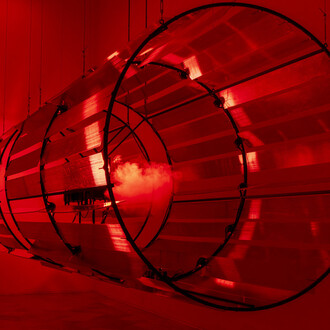The artistic career of Lea Lublin (Brest, Poland, 1929–Paris, France, 1999) spanned five decades. In 1965 she gave up painting and began producing projects that critically examined the concept of representation and perception. Voir clair or “see clearly” became her motto as she questioned the supposed truth of images and subjected them to a process that would reveal their secret meaning. In Argentina, where she studied, Lublin launched two ambitious initiatives—Terrenautas (Terranauts) in Buenos Aires and Fluvio subtunal (Subtunnel Flow) in Santa Fe in 1969—with the primary aim of giving the audience a participatory role, urging them to explore different spaces and reflect on experience through all kinds of sensations. She devised installations like Pénétration d´images (Penetration of Images, 1974), where spectators were invited to walk through curtains on which images of iconic modern works were projected.
Back in France, she conducted interviews and questioned various people (artists, gallerists, critics, students, etc.) to explore the different discourses on art in her Interrogations sur l’art (Interrogations into Art, 1974).
Lea Lublin’s feminist convictions bore their first fruit in Mon fils (My Son, 1968), when she took her own months-old child to an exhibition venue to prove that art and life go hand in hand, and that society automatically assigns caretaking duties to women, forced to juggle two jobs at once. Ten years later, she tossed a banner bearing questions about sexist stereotypes into the Seine, interrogating the society of her day.
As an artist committed to uncovering the truth behind realities and images, she launched an investigation into the veiled eroticism lurking in Renaissance depictions of the seemingly innocent relationship between the Madonna and Child. She also rescued a painting by Artemisia Gentileschi from oblivion and proposed a complex psychoanalytical interpretation of the work.
In the final decade of her career, the 1990s, she examined Marcel Duchamp’s time in Buenos Aires, discovering the places where he stayed and the sources of certain projects, including his famous alter ego Rrose Sélavy.
















